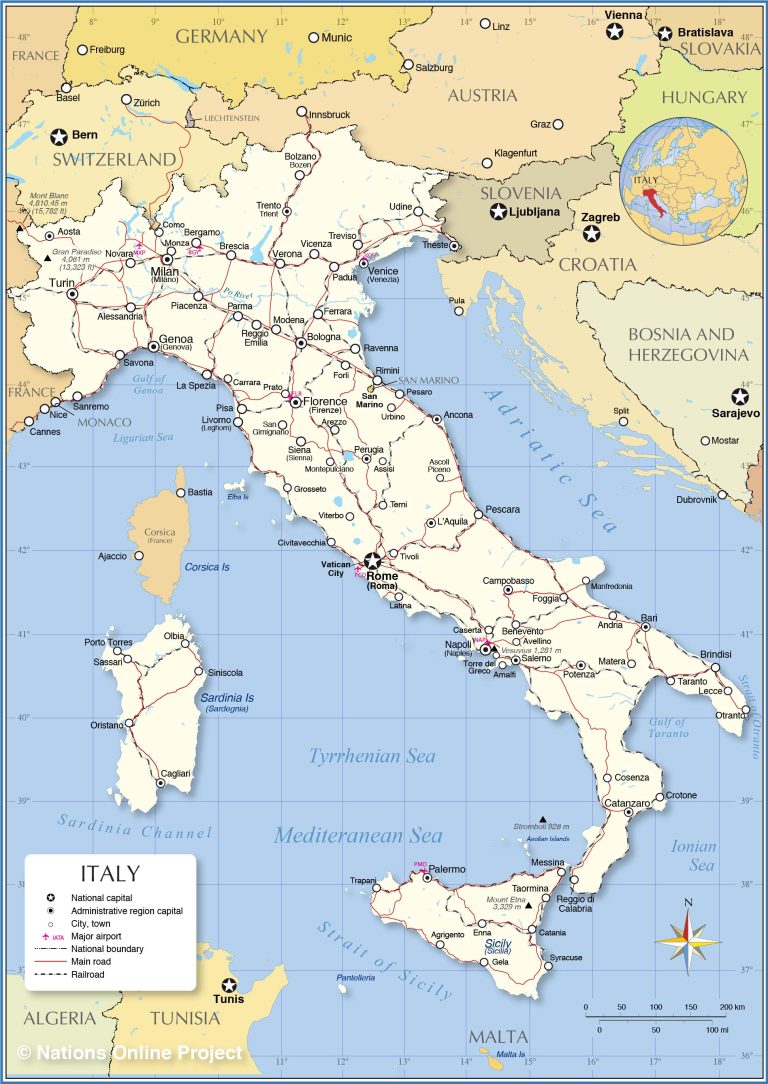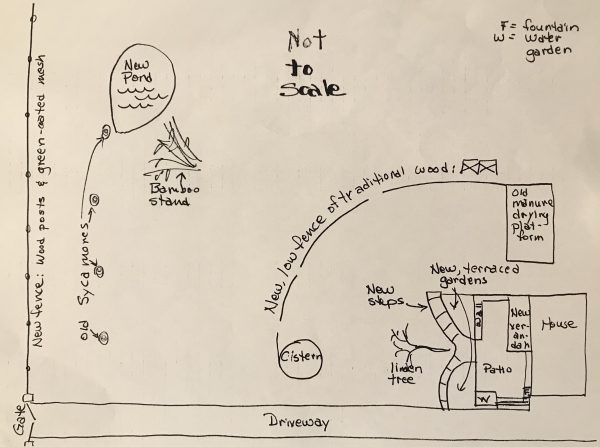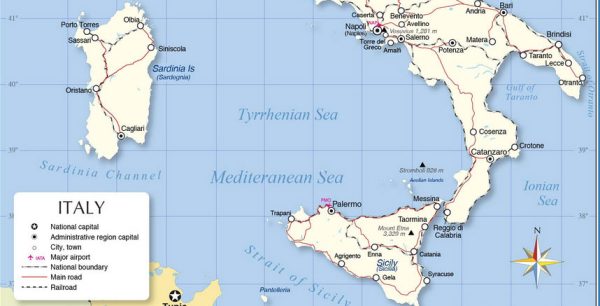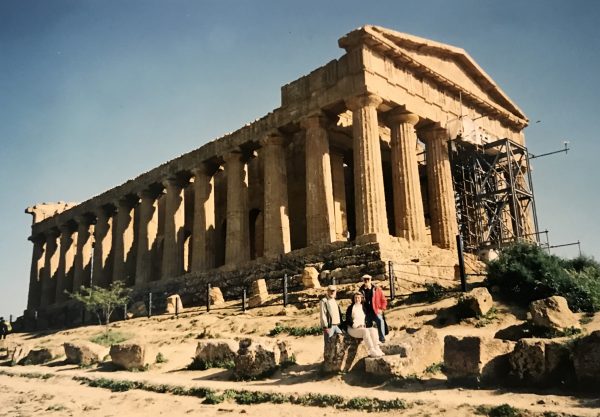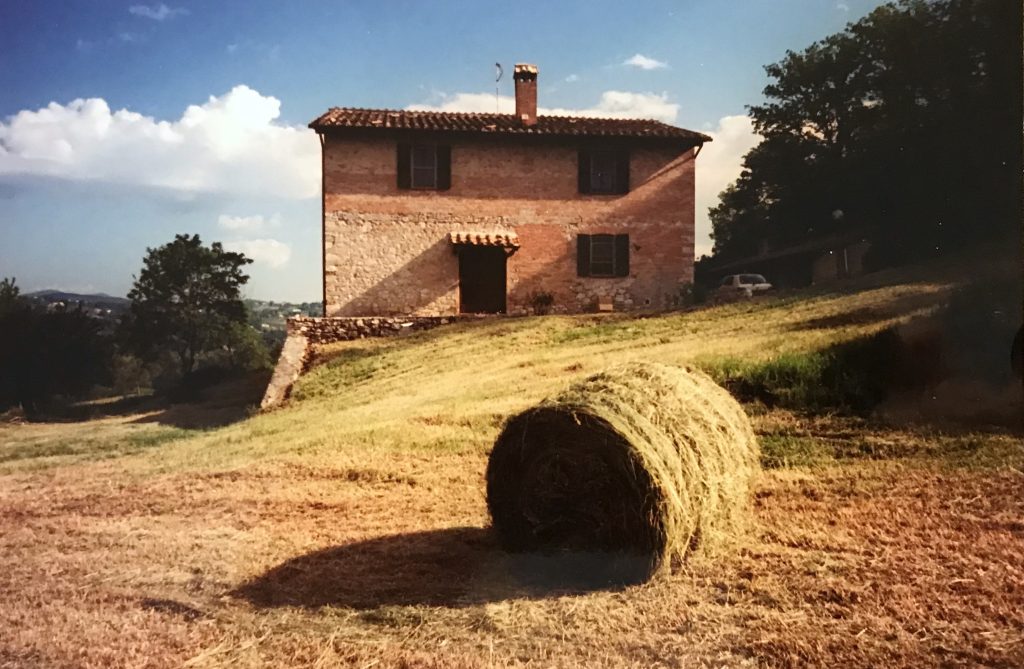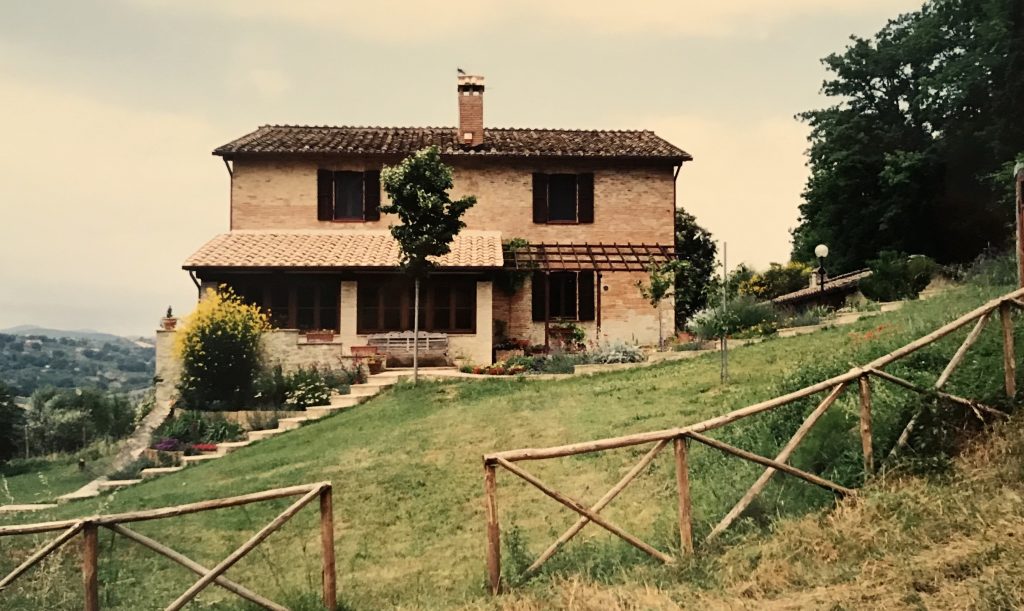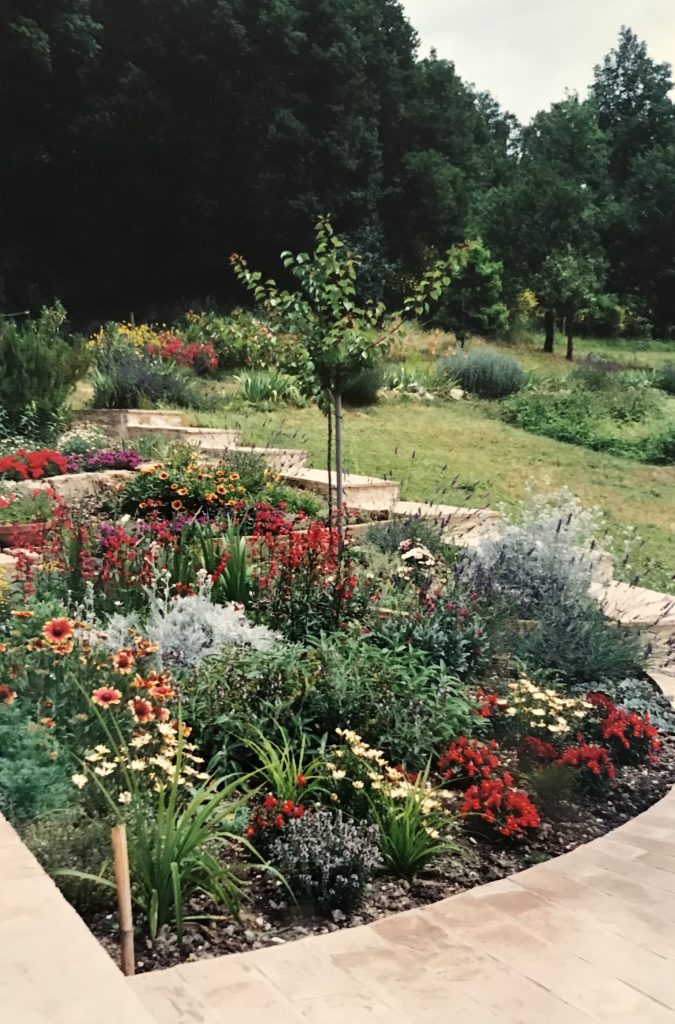#47: Italy: January – June 2001
Starting the Millennium
The first half of 2001 found us starting the new millennium with lots of outdoor projects — a fence, a pond and terraced flower gardens. In between, we managed to continue writing while fighting off serious respiratory infections, entertaining guests and touring Sicily with old friends. Here are excerpts from letters to family and friends.
As always, you can click on photos to enlarge them.
January
We went with handyman and friend Graziano to find fence posts — right at the source, a family logging timber on the side of a mountain. (By the way, it was interesting to note that, unlike Americans, Italians don’t clear-cut. They think it’s wasteful. And since most lumbering — at least in this area — is a family business, it’s cost-effective for them to selectively cut down trees as they attain the right size.) We showed the family our drawings of the planned fences — one with wire mesh to keep Zack in and other dogs out, plus a more traditional, lower one nearer the house made of wood to demarcate the lawn and gardens from the fields. Then we all talked and talked until it was decided how much of each kind of post we’d need. They’ll be delivered around the first of February, and we hope to have the fences done by the beginning of April, when our very own and very full tourist season begins.
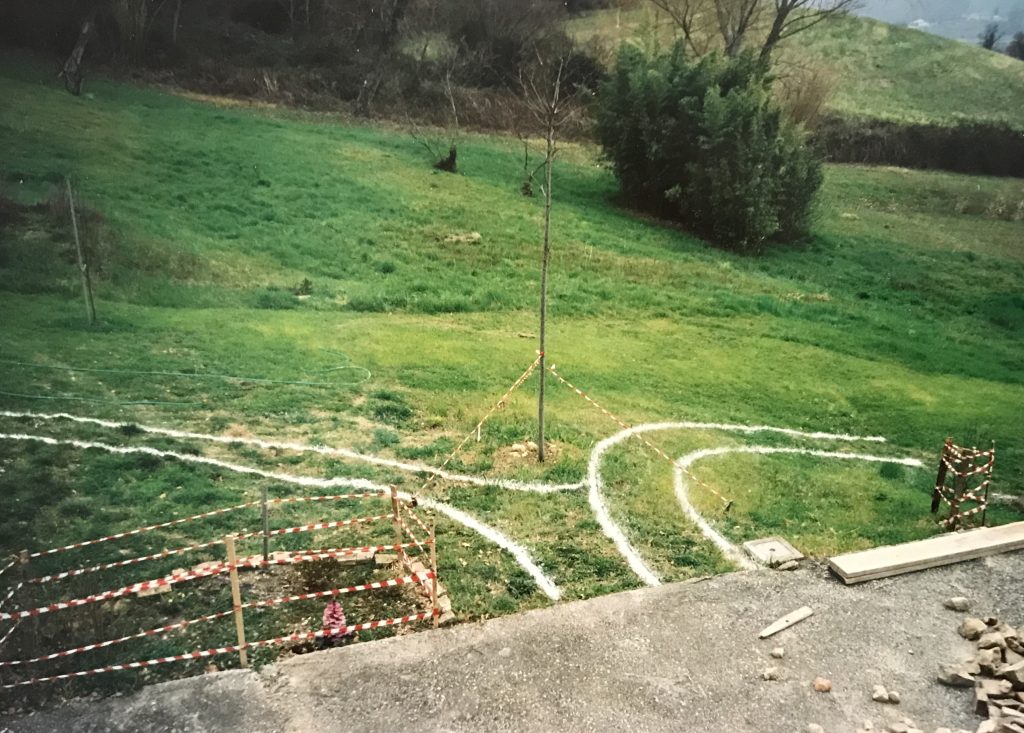
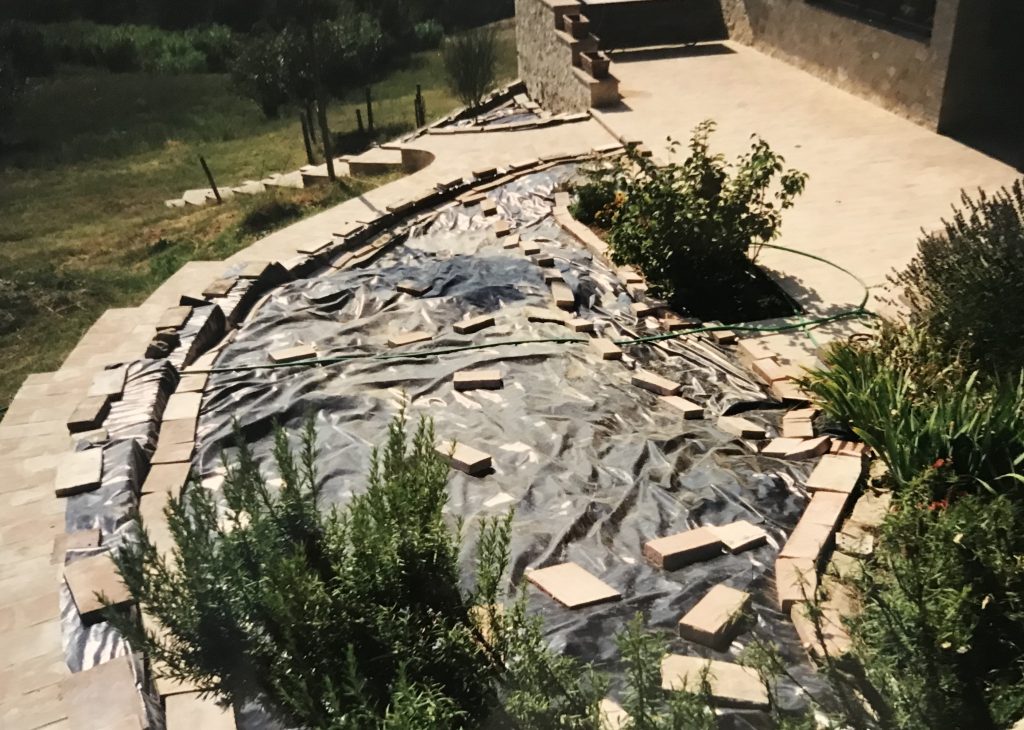
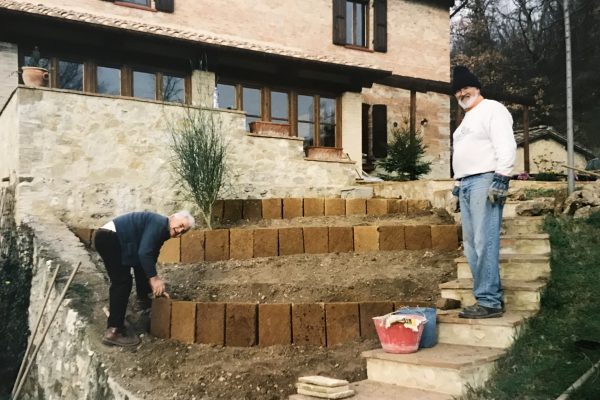 Another project we hope to complete by then is creating two crescent gardens from the spaces formed by the steps Gianni and his mason team created while I was at UCLA last summer. I’d left drawings, and Gianni’d made an outline with gypsum on the grass, so we could be sure we were on the same wavelength about getting to and from our new patio, up to the driveway or down to the “lower forty.” When I returned, all was in place, and now we can start gardening. We’ve had black plastic on top of the grass for months. Now it’s all dead, but it’s still a job to dig out the roots and get the soil ready for planting. R&G have been digging up devil grass, sifting out rocks and creating terraces.
Another project we hope to complete by then is creating two crescent gardens from the spaces formed by the steps Gianni and his mason team created while I was at UCLA last summer. I’d left drawings, and Gianni’d made an outline with gypsum on the grass, so we could be sure we were on the same wavelength about getting to and from our new patio, up to the driveway or down to the “lower forty.” When I returned, all was in place, and now we can start gardening. We’ve had black plastic on top of the grass for months. Now it’s all dead, but it’s still a job to dig out the roots and get the soil ready for planting. R&G have been digging up devil grass, sifting out rocks and creating terraces.
As you may have heard, Italy reported its first case of mad cow disease this month. We’ve been eating all sorts of white meat and being creative about protein substitution. Don’t know how long this will go on — months perhaps — but better safe than sorry.
In the forest behind our house is an old road that winds up the hillside. Neighbor Ornella mentioned that there used to be a “piccolo paese” on top of our hill — a little village. Then Graziano told us that the piccolo paese was Montecampano vecchio. Montecampano now sits on a knoll higher up the ridge, but it was founded on our hill before the birth of Christ. Hundreds of years ago, because of earthquake or war — no one around here seems to know for sure — Montecampano was so completely destroyed that the survivors decided to move up the ridge and start over. But if you follow the old road up our hill, you can still find ruins amid the forest which has overgrown the original village.
February
We both spent most of the month sick. First, respiratory flu; then a secondary respiratory infection. The doctor prescribed cough medicine, an antibiotic for the secondary infection and a mysterious powder that brought down tissue-swelling. Then we got conjunctivitis. Turns out that if you cough a lot, you can send infection up the Eustachian tube connecting your throat and eyes. So we got another prescription. Meanwhile, I’d coughed so much I’d loosened a rib on the left side. Pretty painful, but still necessary to keep coughing to bring the infection up and out. Off the mysterious powder and onto Advil for the pain. We’re down to the last, final gasps and happy to be so.
The worst thing about being so sick was that I’ve gotten way behind on my revision of the novel. I’ve decided just to do the best I can and not worry about it too much. R’s doing the same.
Graziano and his brother Lidio have been working hard, although intermittently, all month to get the fences up. (Please see enclosed diagram.) First, they built a traditional low wooden fence connecting the old cistern with the old manure-drying platform. That will be the boundary between lawn and garden as opposed to the fields. Now, they’re finishing the anti-dog fence that’ll surround about a third of our property, made of chestnut posts and green-plastic-coated wire mesh. On the south and east sides, where it’s backed by forest, and more importantly by blackberry vines, it’s 125 cm high (about a yard and a half). On the north and west sides, where it’s backed by open fields, it’ll be two meters high (c. 6’6″). Once it’s done, we hope for no more fights with hunting dogs, sheep dogs or any other kinds of dogs. Just as importantly, ol’ Zack won’t run off when he catches the scent of a female in heat or a fox passing at dawn. Best of all, the fence will let Zack roam free inside, not chained when sheep flocks are near or during the five months of hunting season.
Before we started on the fences, we went ahead with our pond project, digging where there was a depression hinting there might have been one long ago. Once the fence was up, Paolo and his bulldozer wouldn’t have been able to maneuver. So he started early in the month before we got sick. We kept saying we thought there was a spring down there, but P said he didn’t think so — until he got down deep enough, hit it and got stuck in three feet of slurry. As soon as he freed the spring to rise instead of seeking a lower level where we have a bit of swamp further down the hill, it bubbled up so fast that he couldn’t get out. Two hours and three neighboring tractors later, he was hauled out, and now we have a pond.
I’m stunned and appalled that Taliban is destroying the ancient Buddhist statues of Bamiyan, part of our world heritage. Afghanistan was the crucible for many of the world’s great religions. These statues and the frescoes around them are beyond reckoning in value — historic, spiritual and monetary. It’s like the Chinese destroying their own and the Tibetan heritages. If we don’t know where we’ve been, how can we know where we’re going? A tragedy beyond telling. The new barbarians.
March
It’s beginning to feel like a nature preserve around here. Two pheasants have taken up residence on our property — an incredibly beautiful male and his less colorful mate, a tagged, breeding pair released by the Forest Service and not allowed to be hunted. Then a migrating heron stopped at our new pond — awesome to see him silhouetted against the sunset one evening.
April
Our guest season has begun with a bang. After four years of having guests nearly all year long, we’ve decided to try to do all our hosting in the spring (with the exception of family and super-close friends). That way, we can have some tranquility in which to work and write the rest of the year.
Our first visitors were old friends from Sacramento days, Diane and John Hamlyn. They’ve visited here before, so this time we decided to tour Sicily together. We drove to Naples and took the overnight ferry to Palermo and really lucked out. Instead of getting one of the smelly old ferries that everyone complains about, we got a brand new one — absolutely huge, with two decks for vehicles and four decks for passengers. We had “luxury cabins,” which meant ours had private baths. At our age, none of us wanted to trek down the hall for the inevitable middle-of-the-night latrine break.
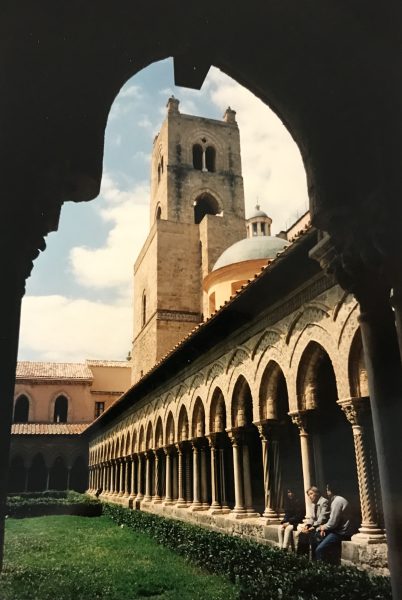 We had drinks in the lounge before dinner and a super meal of broiled fish in the formal dining room. After a smooth crossing — remember the last time we were on a ferry? — we arrived right on time at 7 a.m. the next morning.
We had drinks in the lounge before dinner and a super meal of broiled fish in the formal dining room. After a smooth crossing — remember the last time we were on a ferry? — we arrived right on time at 7 a.m. the next morning.
An easy drive to our hotel, a former mansion, where we stored our luggage and had a nice continental breakfast. Then we walked around the old quarter while our adjoining rooms were being readied beside our private roof terrace filled with semi-tropical, potted plants.
Palermo is a dirty, noisy city, but we managed to see all the sights and eat some wonderful food — puppet museum, art museum, film museum, botanical gardens and the cathedral. We also took a day-trip to Monreale, a hill town high above the city, where we saw its famous cathedral, built to outshine the one down in the city.
Next, it was back in the car and a drive across the island to Agrigento, the site of an ancient Greek city called Akragas. It has, among other things, the finest standing example of a Doric temple in the world. Akragas stood on a bluff above a plain, easily in sight from the sea. It was so wealthy that it dazzled visitors, whose awed writing survives to this day. Fascinating to walk among the ruins, imagining what it must have been like in its heyday. The archeological museum had myriad items that had been excavated, but we most appreciated the recreations of how some of the key temples must have looked.
We stayed that night in a hotel by the sea, then drove to Piazza Armerina, where we visited Villa del Casale, a 3rd-4th century estate of one of the lesser Roman emperors. The villa is famous for its mosaics, preserved by a mudslide in the 12th century. Today, you can spend hours on the walkways above the old pavements, looking at gods and goddesses, mythical heroes and monsters, bikini-clad gymnasts, denizens of the deep, and even one mildly erotic scene tucked away in a back room for the emperor’s private titillation.
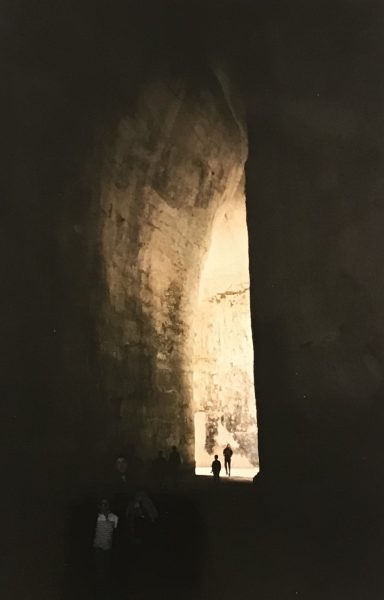 On to Syracuse, one of the great cities of ancient Greece, where Archimedes spoke of moving the earth with a lever and Aeschylus premiered his tragedies in a huge open-air theater that still stands. Today, Syracuse is mostly a baroque city, but we were able to visit the ancient theater, the ruins of the temple of Apollo and huge caves that were the Greek quarries. Plus another wonderful archeological museum, where R&I felt we could have easily spent more time trying to see and comprehend everything — statues, pottery, jewelry, tools, recreations of temples and all. We also visited the art museum, housed in an old palazzo and full of the arts of both Arabs and Europeans, especially from the medieval and Renaissance periods.
On to Syracuse, one of the great cities of ancient Greece, where Archimedes spoke of moving the earth with a lever and Aeschylus premiered his tragedies in a huge open-air theater that still stands. Today, Syracuse is mostly a baroque city, but we were able to visit the ancient theater, the ruins of the temple of Apollo and huge caves that were the Greek quarries. Plus another wonderful archeological museum, where R&I felt we could have easily spent more time trying to see and comprehend everything — statues, pottery, jewelry, tools, recreations of temples and all. We also visited the art museum, housed in an old palazzo and full of the arts of both Arabs and Europeans, especially from the medieval and Renaissance periods.
Back to Palermo, driving across hills, mountains and valleys of an impossible green, misted with flowers of every hue. We purposely took country roads, so we could see Sicily in all her glory. For most of the year, Sicily is dry, hot and sere, but in spring she puts on a show surpassed by none. Every time we crested a ridge, we could see snow-capped Etna with her little plume of steam in the distance. Magical.
We had one more day in Palermo before the ferry left that evening. Di and John had to pick up their rent-a-car, because they were staying a few days more and then driving back to the Rome airport via the short ferry across the straits of Messina and up the Amalfi coast. So R&I went to see the Capella Palatina, a chapel built by the Normans when they ruled the island. It’s truly a little gem, built mostly by Arab artisans left over from the previous rulers, so it combines Arab, Byzantine and Romanesque features.
Back home, we did a lot of planting in our terraced garden. We took the winter-cover off the water garden on the south patio and put in a water lily, as well as 10-12 smaller accent plants. We also added plants to the pond: cattails, yellow flag iris, pickerel weed and several floaters like water lettuce.
May
This has been the Month of Mentors. My dictionary defines “mentor” as a “wise and trusted counselor or teacher.” I’ve been fortunate to have had three in my life, surely more than I deserve. This month, two of them came to stay with us. In between their visits, the third passed away. Oddly these events occurred in the same order in which the three relationships had formed earlier.
When I was at W.V. University, a small miracle happened in my junior year. I was president of the student YWCA, and we got a new Executive Director, Harriet Shetler. Hattie became not only the club advisor, but also my mentor and later, for more than 35 years, my friend. She saved my life more than once, not literally, but in a deeper, profound way when I was looking for meaning in a nonsensical world. She also contributed to the finding of a husband, because it was her daughter, Jane, who introduced Russell and me. So it was with great joy that we welcomed Hattie and Jane for a visit early in May. We had lovely times touring Amelia, Orvieto and Porto Ercole. We ate a lot of good food. We talked a LOT of good talk. Our days together were very special, as if we’d never been separated by time and space.
After I graduated from university, worked in DC and got a master’s degree, I ended up in LA, employed by a consulting firm called Edcodyne. My supervisor was a man named Don Robinson, one of the most remarkable people I’ve ever known, not only for his intelligence, which was very far off the charts, but also for his sensitivity and warmth. He really helped get a raw, young professional off on the right foot. He, too, became a life-long friend, marrying one of my bridesmaids, staying in touch, and visiting here a couple years ago. When I was asked during the oral defense of my doctoral dissertation who had most influenced my thinking, I answered without hesitation, “Don Robinson.” At the end of March, Don was diagnosed with lung cancer and died in mid-May, much sooner than he was supposed to, certainly by the medical prognosis, but especially because none of us who loved him were ready for him to go.
We ended the month on a happier note when Millidge Walker and Irene Tinker came to visit. Millidge was chair of my dissertation committee, and I couldn’t have asked for anyone more supportive. Despite the fact that what I was doing had never been done before at American University’s School of International Service — pulling together the fields of International Development and Development Education — Millidge went to bat for me more than once, fighting off the forces of scholastic conservatism and buying me a chance to try something new. I don’t think I’d ever have attained the degree if it hadn’t been for his support. His wife Irene is also a scholar in her own right, focusing on issues affecting women in developing countries. It was very special to be together again, talking about international development and foreign affairs, remembering shared experiences at AU and touring Amelia and Spoleto.
We had to install a new thermosifone (tair-mo-see-fo-nay). The previous owner was in the construction business and put in a system to heat water and house that looked like it had been created from his projects’ leftovers. Think Rube Goldberg, always causing problems and finally gasping its last gasps. The plumber and the electrician shook their heads and said we’d reached the point where it really didn’t make sense to keep on fixing it. So we ordered a new unit, a simple affair about the size of a basic refrigerator. It’ll heat water and radiate warmth in the house with much more energy efficiency, and it should operate for years with just simple maintenance. It looks so spiffy in the outbuilding’s pump room that we’re going to bite the bullet and paint the room, probably the first new coat in several decades.
June
The new south garden really came into its own this month. When we arrived four-and-a-half years ago, that side of the property was just a cement platform surrounded by grass for haying. We’re enclosing photos to give you an idea of how it’s progressing: a long view showing wooden fence and curving stairs that define the flower gardens, a close-up of the upper garden and another of the lower garden. The tall, yellow-flowering plant is broom. We dug up a very small one two or three years ago, nursed it along and look at it now. Its perfume is marvelous. We’ve come a long way, baby!

COMING NEXT MONTH
#48: Italy, August – December 2001
World Events Intrude
Iowa Summer Writing Festival, 9/11 comes to Italy, Zack attack,
olive harvest off/olive harvest on, staying close to home for pre-Christmas trip

LET ME HEAR FROM YOU.
Please take a moment to share your thoughts.
Your comments help make the blog better, and I always answer.
* * *
If you enjoyed reading this post, I hope you’ll SUBSCRIBE by clicking on the button below. Every month, when I post a new excerpt from my life overseas, you’ll get an email with a link so you can read the next installment. Subscription is free, and I won’t share your contact information with anyone else. Your subscribing lets me know you’re reading what I write, and that means a lot.

